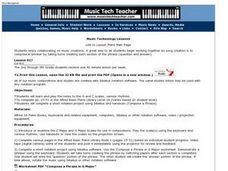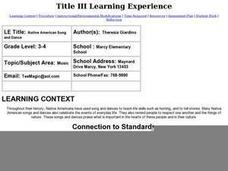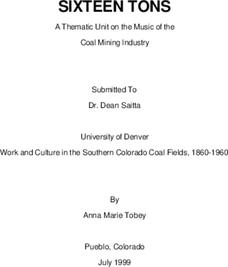Curated OER
Music Technology
Students identify the features of a synthesizer and practice using them. They record different sounds using the software provided. They also examine sound waves and applications through the synthesizer.
Curated OER
Music Creations
Students practice playing notes on the G and C scales in different rhythms. They complete worksheets and discuss the answers. They finish a short notation project as well.
Curated OER
WebQuests
Students work together or individually to complete a WebQuest. They gather information on topics related to music. They also practice their piano lessons in class.
Curated OER
Musical Freeze Improvisions
Students are introduced to the process of creating story from movement through improvisation and invention. When the music is playing, they move. When the music stops, the students freeze. A discussion on the role that music plays in the...
Curated OER
Music Lesson on Rhythm
Pupils listen and examine two musical pieces. They draw pictures about what the music makes them think about. They examine how their pictures are different from slow tempo to fast tempo music.
Curated OER
Teaching Adjectives With Music
Third graders use adjectives to describe objects in a bag. They share which words they used with their classmates. They write adjectives to describe the types of music they listen to as well and share with their classmates again.
Curated OER
Country Singers Take Nashville
Students conduct research on a famous country music singer. In small groups, they conduct research, and construct and decorate a paper cutout of their selected country music singer.
Curated OER
Just a Closer Walk with Thee, Dirty Brass Band
Students investigate the music played by New Orleans brass bands in funerals. The two distinct moods, sad and happy, utilized in the songs are identified and applied to other music selections.
Curated OER
Birdland: Weather Report
Students compare and contrast the Weather Report jazz recording, Birdland, with other songs they have reviewed. They write in their journals how they think charlie Parker might have reacted to the song.
Curated OER
Jam Sessions
Students examine the connection between sense of humor and jazz improvisation by identifying the musical instruments imitated by comedian Bill Cosby. They listen to another recording by Clark Terry and write what they think he might be...
Curated OER
Feelin; a Groove
Students compare and contrast two versions of April in Paris. They discuss the songs in terms of the grooves each one captures and identify the instruments responsible for creating them.
Curated OER
Native American Song and Dance
Students examine the importance of the drum and drumming in the cultural context of the Native American. Musical insturments and native dance is employed to support the focus of the lesson.
Curated OER
SIXTEEN TONS
Students explore a variety of music related to the coal mining industry and organized labor which can be integrated into the study of Colorado History, American Labor History, and a study of immigration.
Curated OER
Heritage: For Some Must Push and Some Must Pull
Students discuss modes of transportation of pioneers, listen to one of the handcart stories, build model handcart out of paper, and sing 'The Handcart Song.'
Curated OER
Centennial: Utah We Love Thee
Fourth graders discuss how music can inspire emotion and are introduced to Utah's state song, "Utah, We Love Thee". They discuss the song and then compare and contrast other songs about Utah. They create original lyrics about Utah.
Curated OER
Six Corners
Students travel to six stations in the room. They move to the center and do push-ups when the number of their location is rolled by the teacher.
Curated OER
Incorporating Japanese Music into the Music Classroom
Fourth graders experience the music and arts of Japan as they explore the language and culture of the country in this instructional activity. A variety of musical elements from the culture are demonstrated.
Curated OER
Reaching the Solar System
Students sing the Rap of the Solar System, view pictures of the planets, and calculate their weights and ages on all the planets and the sun. They create a presentation comparing themselves with a planet or object in the solar system.
Curated OER
Tony Bennett: With Special Guests The Backstreet Boys - Lesson 2
Students clap four-beat rhythm patterns containing whole, half, dotted half, quarter, and eighth notes and rests in a given tempo. They clap the tempo as their teacher holds up flash cards.
Curated OER
Tony Bennett VH1 Storytellers for VH1 Save the Music
Students explore what messages lyrics give to their listeners. They use music from Tony Bennett and the Backstreet Boys.
Curated OER
Tony Bennett VH1 Storytellers for VH1 Save the Music
Young scholars compare two recordings of Tony Bennett's music.
Curated OER
Anecdotes from Artifacts: Hearing When Clay Sings
Learners discover artifacts of the American Indians. They also bring in their own artifact for viewing.
Curated OER
Introduction to the Blues
Students learn the basic elements of blues and different lyric structures.
Curated OER
In My Dream
Learners listen to various selections of music and discuss the use of form in musical compositions. They choreograph and perform movements to correspond with identified forms.

























